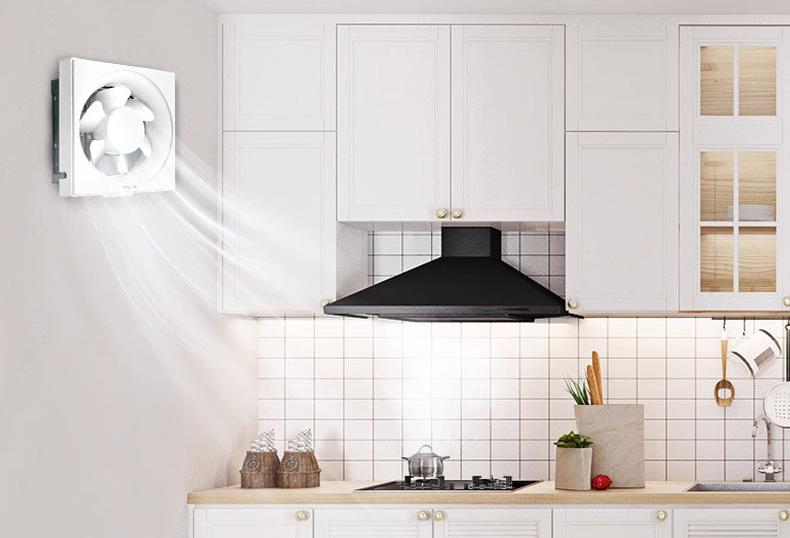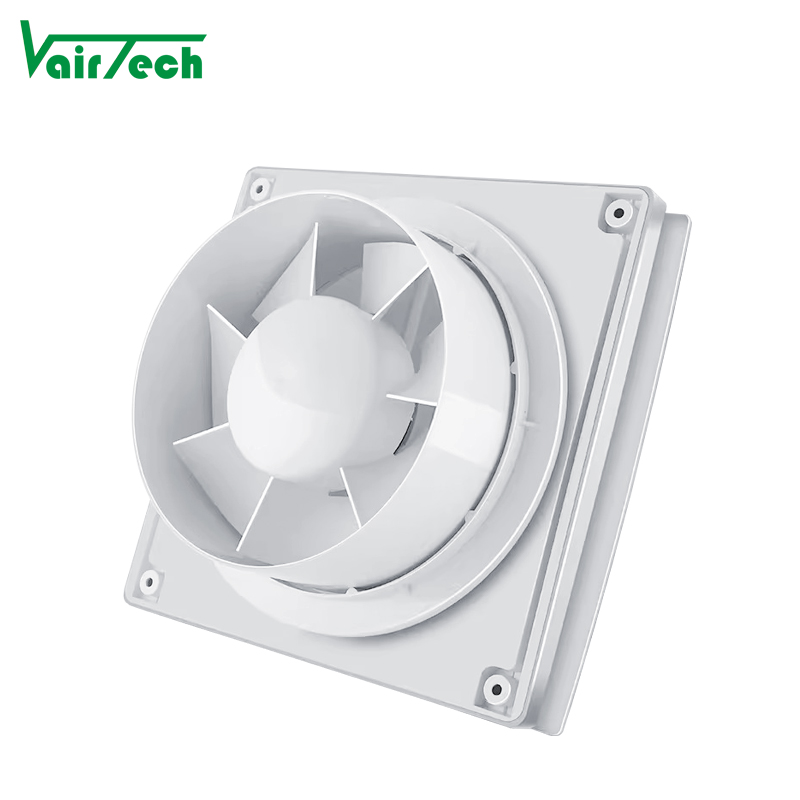Ventilation air grille diffuser
air vent manufacturer since 2002
 Vairtech
Vairtech  2025-08-12
2025-08-12

Exhaust fans and ventilation fans may seem alike as they are used for a similar objective. It is to make sure the air in our homes and workplaces stays fresh and clean. However, they function quite differently. Where an exhaust fan removes stale air from the inside, ventilation fans bring fresh outdoor air inside. Therefore, understanding the difference between exhaust fans and ventilation fans is essential for optimal use.
An exhaust fan is used to expel stale air, moisture, and unwanted odours from a specific area, especially in homes and offices. It draws air from the room and then pushes it outside to improve indoor air quality. These fans are commonly found in kitchens, bathrooms, and other enclosed spaces where proper ventilation is essential. They help prevent the buildup of humidity, smoke, or strong smells, allowing for a more comfortable and healthier environment.
The primary function of an exhaust fan is to remove undesirable air to keep the environment in the space clean and pleasant. An exhaust fan is typically installed on a wall and consists of a propeller fan. When switched on, the fan blades start spinning, drawing air from the room into the fan housing. This creates a pressure difference, forcing the collected air to move outside through a duct or vent. As stale air exits, it makes room for fresh air to enter and improves air circulation for maintaining better air quality.
Here are the advantages that make exhaust fans a must-have for a fresher and more comfortable living space:
Improved air quality: Exhaust fans effectively remove stale air, odours, and pollutants from enclosed spaces like kitchens and bathrooms. The removal of unwanted air promotes fresh air in the room.
Moisture control: These fans help regulate humidity levels by expelling moisture-laden air from the inside. It reduces the risk of having mildew and structural damage in areas prone to dampness, like bathrooms.
Prevents buildup of harmful gases: Exhaust fans continuously expel harmful gases such as carbon monoxide from the living space; thus, acting as a preventive measure against the accumulation of harmful gases.
Temperature regulation: Exhaust fans aid in temperature control by expelling hot air from enclosed spaces. It contributes to a cooler and more comfortable environment, especially in kitchens and confined areas.


Let us explore the uses of exhaust fans that make exhaust fans a valuable addition to different spaces.
Kitchen ventilation: Exhaust fans in kitchens eliminate cooking fumes, smoke, and excess heat. This helps in preventing the buildup of grease and odours while maintaining a cleaner indoor environment.
Bathroom ventilation: These fans are crucial in bathrooms to remove excess moisture or steam produced from showers, baths, and personal grooming activities. By reducing moisture, they help prevent dampness in walls and paint damage.
Industrial settings: Industries use powerful exhaust systems to ensure a safer working environment. Exhaust fans control air quality by removing fumes, dust, and pollutants generated during manufacturing processes.
A ventilation fan is designed to improve indoor air circulation and regulate temperature within a closed working space. Unlike exhaust fans, ventilation fans work to move air throughout the entire structure. They are installed in a specific location, such as ceilings or roofs to draw in fresh outdoor air within the space. These fans are beneficial in closed spaces that typically have limited ventilation options. They help reduce indoor temperatures by pulling in cooler air from outside, especially when the outdoor temperature drops. Ventilation fans come in various designs, including portable and duct fans equipped with louvres or shutters to control the airflow direction.
A ventilation fan operates on the principle of inducing airflow through the building to achieve effective air exchange. When activated, it forces fresh outdoor air to be drawn into the building to optimise indoor ventilation. The fan's functionality is driven by its capacity to move significant volumes of air and is measured in cubic feet per minute (CFM). By enhancing air circulation and promoting a continuous influx of fresh air, ventilation fans contribute to temperature moderation and humidity control.
From maintaining consistent air circulation to providing fresh air from the outside, ventilation fans have a range of advantages. Let us explore some of these:
Complete air circulation: Ventilation fans can facilitate air exchange throughout an entire building while promoting consistent airflow in various zones. They can ensure a more uniform temperature and air quality throughout the working space.
Cost-Effective solution: Ventilation fans have lower operational costs and consume minimal electricity while providing effective air circulation. Additionally, the maintenance costs are lower in the long run when used in industrial settings due to their robust motor.
Consistent supply of clean air: Ventilation fans improve indoor air quality by constantly circulating and renewing the air in a space. This is particularly beneficial in removing pollutants, odours, and excess moisture, to maintain a conducive working environment.
Prevent stagnation: In spaces with limited natural ventilation, such as basements or enclosed areas, ventilation fans help prevent air stagnation. This is essential for avoiding the buildup of pollutants and maintaining a fresh atmosphere.
Now that we are aware of the advantages of ventilation fans, it is time to explore its utility in numerous workplaces. Here are some practical applications of ventilation fans:
Industrial and commercial settings: These fans are a crucial part of the air supply ventilation system used to regulate air quality by expelling fumes, dust, and contaminants generated by various activities. Ventilation fans enable fresh air circulation to provide a safer and healthier working environment for employees.
Greenhouses: By circulating fresh air and expelling excess heat and moisture, ventilation fans help to improve the efficiency of a greenhouse. As they contribute to maintaining appropriate temperature and humidity levels in greenhouses for enhanced plant growth.
Server rooms and data centres: Ventilation fans are crucial in maintaining optimal temperatures in server rooms to prevent equipment overheating and ensure efficient operation of electronic systems.
Let us understand the difference between an exhaust fan and a ventilation fan by comparing them in various aspects.
Purpose and function:
Exhaust fan: Primarily focused on removing stale air, moisture, and odours from specific areas like kitchens, bathrooms, or confined spaces. It expels air from a specific location to the outside.
Ventilation fan: Designed to circulate air throughout an entire building or specific zones. Promoting overall air exchange and temperature regulation. It draws in fresh outdoor air while expelling indoor air.
Location and installation:
Exhaust fan: Typically installed on walls of specific rooms where targeted air removal is needed, such as kitchens and bathrooms.
Ventilation fan: Often placed in attics, ventilation ducts or roofs within a building to ensure even airflow throughout the entire structure.
Airflow direction:
Exhaust fan: Moves air in one direction – from inside the room to the outside, creating localised airflow.
Ventilation fan: Facilitates two-way airflow, expelling indoor air while drawing in fresh outdoor air, promoting circulation throughout the building.
Scope of impact:
Exhaust Fan: Affects a specific area or room, targeting smaller areas for air quality improvement.
Ventilation fan: Impacts the entire building or designated zones, contributing to overall air quality and temperature regulation.
Temperature and humidity control:
Exhaust Fan: Primarily focuses on removing moisture and odours, aiding in humidity control and air quality improvement in targeted areas.
Ventilation fan: Helps regulate temperature by drawing in cooler outdoor air, reducing indoor temperatures, and aiding in overall humidity control.
Determining the right type of fan depends on several factors and your specific needs. Here are some key factors to consider:
Identify the purpose: If you need to remove moisture, odours, or smoke from a specific room like a kitchen or bathroom, an exhaust fan might suffice. For overall air circulation and temperature control throughout the living space, you might need a ventilation fan.
Assess location: Evaluate the area where the fan will be installed. If it is a single room requiring targeted air removal, an exhaust fan placed on the wall might be appropriate. For whole-house air circulation, consider a ventilation fan installed in an attic or a central location.
Consider room size and airflow requirements: Calculate the size of the room or building and the required airflow. The exhaust fan’s airflow capacity is measured in CFM (cubic feet per minute) and is more focused on stale air removal. Ventilation fans often move larger volumes of air and are suitable for broader coverage.
Budget and energy efficiency: Consider your budget constraints and energy efficiency preferences. While exhaust fans tend to be more cost-effective for smaller areas, ventilation fans might incur higher initial costs with large carpet areas.
Both exhaust and ventilation fans serve critical roles in maintaining air quality and overall comfort within different spaces. However, the choice between the two depends on specific needs. If you are looking to buy exhaust fans for your house, Vairtech's exhaust fans can be a suitable option for you. These fans easily expel odours and humidity while providing optimal ventilation and more comfortable indoor environments.
Revitalise your living space with Vairtech exhaust fans for clean and fresh air.